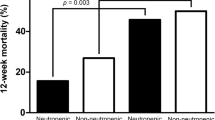Abstract
Patients with hematological malignancies who are receiving chemotherapy suffer prolonged periods of neutropenia, which leads to a greater risk of infection and mortality. A prospective study was conduced to determine the incidence of bacteremia in patients of hematological malignancies over a 2-yr period. A total of 119 episodes of febrile neutropenia occurred among 96 consecutive patients, of which 35 episodes were associated with bacteremia. Forty-four percent of the isolated bacteria were Gram-positive aerobes and 46% were Gram-negative aerobes. Staphylococcus aureus, Enterococcus spp., and Escherichia coli were the most common isolates. Gram-negative bacteremia was associated with a higher mortality. Anaerobes accounted for 4.4% of all isolates. The episodes of anaerobic bacteremia were polymicrobial and had a fatal outcome. A high incidence of antimicrobial resistance among aerobic and anaerobic bacteria was also recorded. Compared to previous years, a shift from a predominating Gram-negative to a Gram-positive etiology was noted. The initial empiric antibiotic regimens should be based on a local knowledge of the most common causative microorganisms, their sensitivity pattern, and the outcome of bacteremia.
Similar content being viewed by others
References
Rubio, M., et al. (1994). Predominance of Gram-positive microorganisms as a cause of septicemia in patients with hematological malignancies. Infect. Control Hosp. Epidemiol. 15, 101–104.
Rolston, K.V. and Bodey, G.P. (1995). Infections in patients with cancer, in Cancer Medicine, 4th ed. (Holland, J.F., Bast, R.C., Morton, D.L., Frei, E., Kufe, D.W. and Weichselbaum, R.R., eds), pp. 3303–3333. Williams and Wilkins, Baltimore.
Freifeld, A.G., Walsh, T.J. and Philip, A. (1997). Infections in the cancer patient, in Cancer. Principles and Practice of Oncology, 5th ed. (DeVita, V.T., Jr, Hellman, S. and Rosenberg, S.A. eds), pp. 2659–2704, Lippincott-Raven New York.
Collee, J.G., Miles, R.S. and Watt, B. (1996). Tests for the identification of bacteria, in Mackie and McCartney. Practical Medical Microbiology. 14th ed. (Collee, J.G., Fraser, A.G., Marmion, B.P. and Simmons, A., eds), pp. 131–145, Churchill Livingstone, New York.
Forbes, B.A., Sahm, D.F. and Weissfeld, A.S. (1998). Bailey and Scott’s Diagnostic Microbiology, 10th ed. (Baron, E.J., Peterson, L.R., and Feingold, S.M., eds.), Mosby, St. Louis, MO.
Sutter, V.L., Citron, D.M., Finegold, S.M., et al. (1985). Wadworth Anaerobic Bacteriology Manual, 4th ed., Los Angeles, California.
Willis, A.T. (1960). Anaerobic Bacteriology in Clinical Medicine, Butterworth, London.
Miles, R.S. and Amyes, S.G.B. (1996). Laboratory control of antimicrobial therapy, in Mackie and McCartney. Practical Medical Microbiology, 14th ed. (Colle, J.G., Fraser, A.G., Marmion, B.P., and Simmons, A. eds), pp. 151–177, Churchill Livingstone, New York.
Johansson, P.J.H., Sternby, E. and Ursing, B. (1992). Septicemia in granulocytopenic patients: a shift in bacterial etiology. Scand. J. Infect. Dis. 24, 357–360.
Engervall, P. and Bjorkholm, M. (1995). Infections in neutropenic patients I: aetiology. Med. Oncol. 12, 251–256.
Kasthuri, A.S., et al. (1990). A clinical study of adult leukaemias. J. Assoc. Physicians India 38(6), 403–406.
Kumar, L., Kochupillai, V. and Bhujwala, R.A. (1992). Infections in acute myeloid leukemia: study of 184 febrile episodes. J. Assoc. Physicians India 40(1), 18–20.
Aquino, V.M., Pappo, A., Buchanan, G.R., Tkaczewski, I. and Mustafa, M.M. (1995). The changing epidemiology of bacteremia in neutropenic children with cancer. Pediatr. Infect. Dis. J. 14, 140–143.
Suppola, J.P., Kuikka, A., Vaara, M. and Valtonen, V.V. (1998). Comparison of risk factors and outcome in patients with Enterococcus faecalis vs Enterococcus faecium bacteremia. Scand. J. Infect. Dis. 30(2), 153–158.
Goldstein, E.J.C. (1996). Anaerobic bacteremia. Clin. Infect. Dis. 23(Suppl. 1), S97-S101.
Finegold, S.M. and Wexler, H.M. (1996). Present status of therapy for anaerobic infections. Clin. Infect. Dis. 23(Suppl. 1), S9-S14.
Author information
Authors and Affiliations
Corresponding author
Rights and permissions
About this article
Cite this article
Mathur, P., Chaudhry, R., Kumar, L. et al. A study of bacteremia in febrile neutropenic patients at a tertiary-care hospital with special reference to anaerobes. Med Oncol 19, 267–272 (2002). https://doi.org/10.1385/MO:19:4:267
Received:
Accepted:
Issue Date:
DOI: https://doi.org/10.1385/MO:19:4:267




